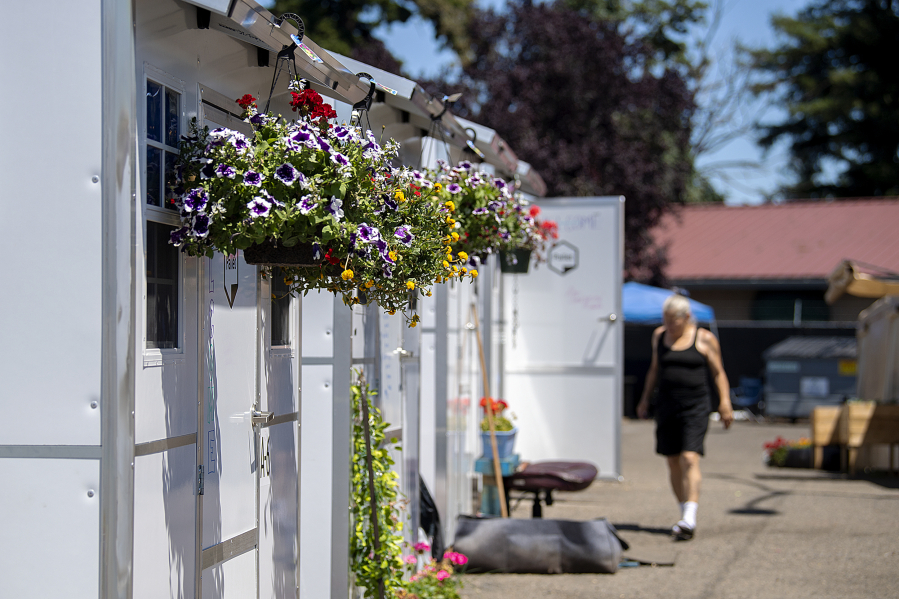People are entering homelessness faster than Clark County agencies can house them.
Despite efforts and new strategies by housing officials, 2022 data recently pulled from the Homeless Crisis Response System showed that homelessness is rising in Clark County, with 9,032 people from 5,352 households identified in 2022. Two-thirds of them were newly homeless.
The data, compiled based on the number of individuals who called for assistance last year, showed that people of color are still disproportionately impacted by housing instability. It also showed that youth and veterans’ homelessness hasn’t budged despite strategies.
The increase represents a 43.7 percent increase from 2021 levels, when the council reported 6,285 people experiencing homelessness.
“Homelessness does not exist in a vacuum of bad individual choices and circumstances,” said Laura Ellsworth, strategic partnerships and advocacy manager for Council for the Homeless. “The pressures that are squeezing people and communities causing homelessness are only increasing as rents have gone up, housing stock remains at critical short supply and impacts of a global pandemic continue to be felt.”
Just like the point-in-time count data, which counted 1,300 people experiencing homelessness in one evening in January, the Homeless Crisis Response System data may not capture every person unhoused in Clark County.
“The numbers tonight are the households who called the housing hotline. It’s likely that some households experienced homelessness and did not call for assistance,” Ellsworth said.
More people, fewer homes
Sixty-eight percent of people counted identified as newly homeless, according to data — a 7 percent increase from 2021.
The inflow of people experiencing homelessness for the first time is driven by lack of affordable housing, high rental rates and lofty cost-of-living prices. These factors impact how many people are entering homelessness and hindering people from leaving homelessness through permanent housing.
“Finding a permanent home in Clark County has become less affordable and less attainable,” said Ellsworth. “A safe, secure home is out of reach for much of our population. We have a housing shortfall of about 103,000 units in Clark County. In other words, we have too few units overall and not enough vacancies among existing rental units.”
In Clark County, rent for a one-bedroom apartment averages $1,580 per month.
A widely accepted guideline recommends that individuals spend no more than a third of their income on housing. Recent data from the Washington Low Income Housing Coalition said that renters would have to earn at least $30 an hour in a full-time job to meet that 30 percent affordability standard.
When people pay more than 30 percent of their income on housing, they are more at risk to financial strains and housing instability.
“We don’t have enough low-income units to allow those living on the streets to secure permanent homes. There are not enough middle income units to allow those living in low-income housing to move up into the next level and so on,” said Ellsworth.
People of color disproportionately impacted
The report highlighted that people of color are significantly more likely to experience poverty and homelessness in Clark County.
People of color make up about 15 percent of the county’s population but make up 44 percent of the area’s unhoused population (3,985), according to last year’s data — a 4 percent increase from 2021.
Council for the Homeless said that people of color represented 54 percent of the families served by the agency last year, with at least one member of a household identified as a person of color.
Siobhana McEwen, advocacy and equity director for the council, said racial equity needs to be at the center of homeless responses.
“We need to see policy changes that are accounting for the fact that housing doesn’t look the same for all people,” said McEwen. “And solutions to housing instability aren’t necessarily the same for people of color as they are for white folks.”
Youth homelessness
Just over 920 children ages 0 to 5 experienced homelessness in 2022, and 843 kids ages 6 to 11 years old were identified in homeless data last year. These children are identified with families.
The number of unaccompanied youths experiencing homelessness held steady from 2021 to 2022, with 788 children ages 12-17 experiencing homelessness, and 788 again for those ages 18-24.
“Youth often face unique and broad barriers to resolving their homelessness. They’re often struggling to identify not necessarily knowing the system and how to identify services,” said Sunny Wonder, deputy director of the council. “And (they) are really focused on daily survival, so their homelessness may look a bit different.”
Wonder said youth typically couch-surf or move around frequently, which can create barriers to accessing services or seeking more permanent housing.
“Another really big factor is that our system is often not designed to help people under the age of 18,” said Wonder.
Youth under the age of 18 are typically not able to sign a rental lease and have limited income. Wonder said the young people were often the first to be laid off at the start of the pandemic. Youth still may be facing the impacts in 2022.
One strategy that the county is using to alleviate student homelessness is through a partnership through the Homeless Student Stability Program, which allows the council to work with family community resource centers in Vancouver and Evergreen school districts. Since 2016, the Homeless Student Stability Program has helped support homelessness nationwide by providing funding to school districts and local agencies.
Students who are identified as experiencing housing instability through the schools are connected with community resources.
What age is most common in homelessness?
The most common age group to call the council hotline in 2022 were ages 25-34 (1,679 people), 35-44 (1,637 people) and 45-54 (1,116 people).
Out of the 9,032 people experiencing homelessness during 2022, 1,038 were seniors ages 55-69 and 143 were age 70 or older.
Wonder said seniors face unique challenges to ending homelessness and exiting poverty.
“As you can imagine, seniors are often on fixed income and they’re not always able to go and get a job,” she said. Compounding health issues and disabilities are also factors playing into homelessness for this group.
Where are people from?
A common question raised by Clark County residents is whether people experiencing homelessness are traveling from Portland to Vancouver, yet data shows otherwise.
In 2022, out of all households identified as unhoused, 87 percent were from Washington, with 4,310 from Clark County and 3,898 from Vancouver. Just under 7 percent of people said they were from Oregon, with 3.7 percent (195) identifying Portland.
Just over 1 percent said they were from California.
The council’s numbers do not represent all people experiencing homelessness last year, as 17.8 percent of adults did not have a valid “ZIP Code of Last Permanent Residence” recorded in their Homeless Management Information System.
What is working?
In 2022, more rental assistance than ever before was distributed in Clark County: $26,116,410. Council for the Homeless said that more than 5,200 households were stabilized due to emergency rental assistance.
In early 2022, the number of outreach workers from seven agencies increased to 30.
The county also had an increase in emergency shelter beds — 120 were added in December 2021, and 72 were added in 2022 — a year-round total of 393 shelter beds.
In 2022, 47 percent of households who were served through rapid re-housing exited to permanent housing. The rate of people returning to houselessness after rapid re-housing was 14 percent last year.
Forty-seven percent of people who were entered into transitional housing (temporary housing with supportive services) became permanently housed afterward, with 10 percent returning to homelessness.
The data shows 93 percent of people taking part in the Permanent Supportive Housing transitioned to permanent housing; 13 percent returned to homelessness.
“It is easy to focus on the visible homelessness in this community, but we are doing really, really great work. We just need to do more with more resources,” said Executive Director Sesany Fennie-Jones.




